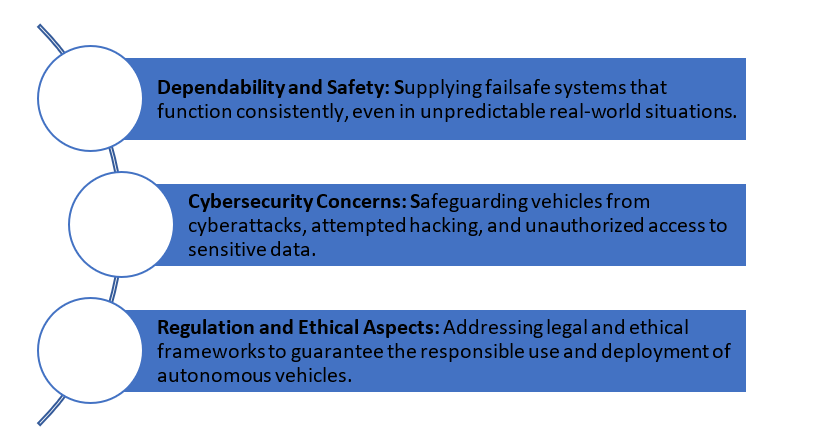By: Arya Brijith, International Center for AI and Cyber Security Research and Innovations (CCRI), Asia University, Taiwan,sia University, Taiwan, arya.brijithk@gmail.com
Self-driving automobiles, which seamlessly integrate computer algorithms with physical components to navigate and interact with the real environment, epitomize the essence of cyber-physical systems (CPS).
Keywords CPS, cybersecurity, self-driving car, AI
Introduction
Self-driving cars represent a revolutionary advancement in the automotive industry, fusing physical components and sophisticated computer algorithms to navigate and interact with the real environment. These vehicles demonstrate the seamless integration of computer power and physical movement, epitomizing the essence of cyber-physical systems (CPS). As a quintessential example of CPS, this article explores the multifaceted realm of self-driving automobiles, its advantages, and inherent challenges in their development and implementation.
Advantages of implementing AI in CPS
- Enhanced Safety: AI-driven systems use sensors and cameras to continually monitor the environment around the vehicle. Compared to human drivers, they can react more quickly, identifying potential risks and taking appropriate action in milliseconds, potentially lowering the number of accidents caused by human error.
- Rеal-timе Dеcision-making: Massive volumes of sensor data are processed in real-time by AI systems. This allows the vehicle to make split-second decisions based on current environmental circumstances including navigation, route planning, lane changes, and obstacle avoidance.
- Adaptive Education: AI-equipped self-driving cars are capable of learning from their on-road experiences. Their capacity to navigate and handle a variety of driving scenarios is improved by their constant refinement of algorithms and decision-making processes.
- Accessibility and Mobility: By providing a safer and more convenient mode of transportation, self-driving cars have the potential to provide transportation options for people with limited mobility, such as the elderly or people with disabilities.
- Reduced Human Error: Artificial intelligence systems are immune to human distractions, fatigue, and emotional variables that may influence human drivers. This lessens the possibility of accidents brought on by human error, including distracted or sleep-deprived driving.

Conclusion
Artificial Intelligence in self-driving automobiles has accelerated transportation into a new era where mobility is redefined by cyber-physical systems. These vehicles are equipped with AI-driven systems that improve accessibility, safety, and efficiency while fundamentally changing the transportation landscape. There has been a notable advancement in automotive technology with its capacity to process real-time data, make split-second decisions, and learn from experiences on an ongoing basis. However, obstacles including legal frameworks, moral considerations, cybersecurity risks, and societal acceptance continue to be major roadblocks in the way of widespread implementation. Despite these obstacles, the development of self-driving automobiles as cyber-physical systems promises a future in which more accessible, safe, and efficient transportation becomes a reality, changing how people interact with mobility on roadways.
References
- Fulton, N., & Platzer, A. (2018, October). Safe ai for CPS. In 2018 IEEE International Test Conference (ITC) (pp. 1-7). IEEE.
- Albasir, A., Naik, K., & Manzano, R. (2023). Toward Improving the Security of IoT and CPS Devices: An AI Approach. Digital Threats: Research and Practice, 4(2), 1-30.
- Putnik, G. D., Shah, V., Putnik, Z., & Ferreira, L. (2021). Machine Learning in Cyber-Physical Systems and manufacturing singularity–it does not mean total automation, human is still in the centre: Part II–I n-CPS and a view from community on Industry 4.0 impact on society. Journal of Machine Engineering, 21, 133-153.
- Mishra, A., Gupta, B. B., Peraković, D., Yamaguchi, S., & Hsu, C. H. (2021, January). Entropy based defensive mechanism against DDoS attack in SDN-Cloud enabled online social networks. In 2021 IEEE International Conference on Consumer Electronics (ICCE) (pp. 1-6). IEEE.
- Gupta, B. B., & Chaturvedi, C. (2019, July). Software defined networking (SDN) based secure integrated framework against distributed denial of service (DDoS) attack in cloud environment. In 2019 International Conference on Communication and Electronics Systems (ICCES) (pp. 1310-1315). IEEE.
- Kumar, A., Shankar, A., Behl, A., Arya, V., & Gupta, N. (2023). Should I share it? Factors influencing fake news-sharing behaviour: A behavioural reasoning theory perspective. Technological Forecasting and Social Change, 193, 122647.
- Sharma, A., Singh, S. K., Badwal, E., Kumar, S., Gupta, B. B., Arya, V., … & Santaniello, D. (2023, January). Fuzzy Based Clustering of Consumers’ Big Data in Industrial Applications. In 2023 IEEE International Conference on Consumer Electronics (ICCE) (pp. 01-03). IEEE.
Cite As
Brijith A. (2023) Self-driving cars: An AI-embedded cyber-physical system, Insights2Techinfo, pp.1